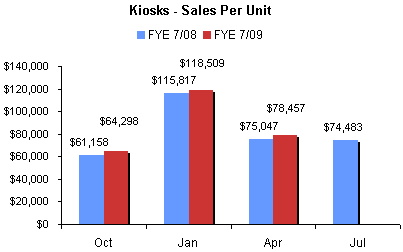IDEX Online Research: Piercing Pagoda is Zale’s Over-Looked Stepchild
July 14, 09
Zale’s Piercing Pagoda operation was the shining star in Zale’s most recent quarter ended April 2009. This often-overlooked retail segment, with 700 kiosk units which contributed only about 12 percent of Zale’s total corporate revenues last year, posted the following financial results for the April quarter:
- Sales were down only 3 percent to $54.4 million from last year’s $56.1 million in the Piercing Pagoda segment. In contrast, sales in Zale’s fine jewelry segment were down by a dramatic 23 percent to $321.4 million in the April quarter. Jewelry industry sales in the same period were down about 12 percent.
- Sales per store were up nearly 5 percent in the April quarter versus the same period a year ago. This year, Piercing Pagoda’s sales per store in the quarter were $78,457 versus last year’s $75,047.
- Piercing Pagoda posted a small operating profit in the April quarter (yes, you read that correctly: a profit – of about $500,000). It was only one of a very few U.S. jewelers to post an operating profit in the three-month period. In contrast, the operating loss in Zale’s fine jewelry segment widened by 67 percent to $28.5 million in the quarter, its operating margin was a loss of 8.9 percent.
- These favorable trends at Piercing Pagoda have more or less characterized the past few quarters.
If short term results look solid, take a look at the longer term picture: last year, the 700+ Piercing Pagoda kiosks produced a whopping 30 percent of Zale’s store operations profits (before unallocated corporate expenses), even though they generated just 12 percent – $249.5 million – of Zale’s corporate revenues of $2.138 billion. In the current fiscal year ending July 2009, it appears that these kiosks will the only retail operating segment to produce an operating profit for Zale, in contrast to the fine jewelry stores which will unquestionably produce an operating loss for the full year (unless a miracle occurs).
It is worth noting here that the most profitable segment of Zale’s business is not any of its store operations. Rather, it is the insurance operation, driven primarily by the sale of merchandise warranties. Last year, the insurance operation generated 0.6 percent of total corporate revenues (less than 1 percent), but produced 15 percent of operating profits, prior to unallocated corporate costs. This year, the insurance operations are on track to generate more operating profit dollars than any other segment of Zale’s business.
Piercing Pagoda Background
Zale purchased Piercing Pagoda in September 2000. Previously, it had been a public company, trading on the over-the-counter market as PGDA. Our recollection of Piercing Pagoda in the late 1990s was that it was a company with a simple business that hummed along and made a tidy profit. For its final stand-alone fiscal year ended March 2000, the duo-management team of Richard Penske and John Eureyecko led Piercing Pagoda to produce a solid pretax profit of 7.7 percent, consistent with prior years’ levels. The company had 940 kiosks and generated $280.7 million in sales that year, with sales per location of just under $299,000.
Today, there are about 700 Piercing Pagoda kiosks which produced $249.5 million of sales last year, with sales per location of about $328,000. Its operating margin was 4.0 percent, prior to corporate charges; the pretax margin was not disclosed. Based on about $250 million of sales, Piercing Pagoda would be ranked as the 23rd largest retailer of jewelry in the U.S., between Blue Nile ($268 million in U.S. sales in 2008) and Kohl’s ($240 million sales in 2008). Among specialty jewelers, it would be about the 13th largest, if it were to stand alone.
Zale’s “kiosk jewelry” segment consists of kiosks – small structures in mall walkways from which jewelry is sold – operating under the brand names of Piercing Pagoda, Plumb Gold and Silver & Gold Connection, collectively called Piercing Pagoda. At the end of the most recent fiscal year, there were Piercing Pagoda kiosks in malls in 42 states and Puerto Rico. These kiosks specialize in gold and silver products, including entry level diamond merchandise. They capitalize on the latest fashion trends, and target young, fashion-forward customers. Merchandise includes an extensive collection of bracelets, earrings, charms, rings and gold chains, as well as a selection of silver and diamond jewelry at very moderate prices. Some of the sales associates in Piercing Pagoda units are trained to pierce ears for their customers.
The Piercing Pagoda kiosk locations average 188 square feet (versus 1,536 square feet for a typical Zale / Gordon’s store) and generate an average transaction of $40 (in contrast to Zales / Gordon’s average ticket of $370). Based on store size, the typical Zales / Gordon’s store produces sales of $814 per square foot, while Piercing Pagoda’s sales per square foot are more than double at $1,744.
Over the years, Piercing Pagoda has had to play “second fiddle” to its 800-pound gorilla sibling, the fine jewelry segment including Zales, Zale’s Outlets, Gordon’s, Peoples, Mappins, and the recently divested Bailey Banks & Biddle. That’s no surprise: Piercing Pagoda has historically averaged only 11 percent of corporate revenues. When problems arise in the fine jewelry segment, which generates 89 percent of corporate revenues, management puts its energy where the potential payback is the largest. As a result, Piercing Pagoda has had a succession of management changes over the years, with a lack of focus, in our opinion. While we would not relegate it to the status of the proverbial “red-headed step-child,” it has necessarily taken a back seat to the fine jewelry segment.
While Zale continues to get bad press about its disappointing financials, and management spends most of its time explaining how it is going to fix those problems – which are virtually all in the fine jewelry segment – Piercing Pagoda continues to hum away, just as it did in the late 1990s: sales are singing along, and profits, while diminished, continue to pour from it.
From time to time, it is rumored that Piercing Pagoda is for sale. If so, we know people who would like to be first in line to buy it. As we said, it is a relatively simple business, and, run properly, it can produce potentially immense profits.
In its legal filings, Zale discloses sales for its “fine jewelry” segment and its “kiosk” segment. For a while, the kiosk segment included both Piercing Pagoda units and Peoples II units in Canada. The Peoples II operation was discontinued in early 2007. Thus, the latest financial information which Zale discloses for its “kiosks” is pure enough to be virtually solely related to Piercing Pagoda and related brands under its segment umbrella.
Piercing Pagoda Analysis Yields Surprisingly Solid Financial Results
We analyzed “kiosk” financial results by fiscal quarter versus “fine jewelry” financial results. Because Zale’s fiscal year ends in July, its first fiscal quarter ends in October, and so on. The graphs below illustrate results for the company’s fiscal quarters, not traditional calendar quarters.
Here’s what we found:
- Total sales by fiscal quarter in the fine jewelry segment – traditional jewelry stores including Zales, Gordon’s, Zale’s Outlet, and Peoples – have been slowing since the third calendar quarter of 2008. That makes sense, since jewelry demand dried up late in the third quarter of last year.
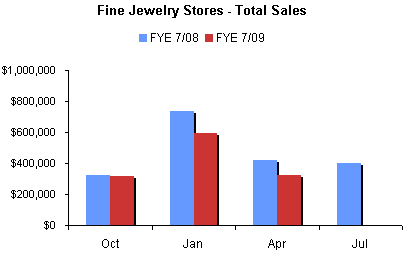
Source: Zale Corporation
- Total sales by fiscal quarter in the kiosk segment – Piercing Pagoda – slowed in the quarter ended January 2009 versus the same quarter a year ago, but have almost bounced back to last year’s levels in the most recent quarter ended April, as the red bar (April) illustrates.
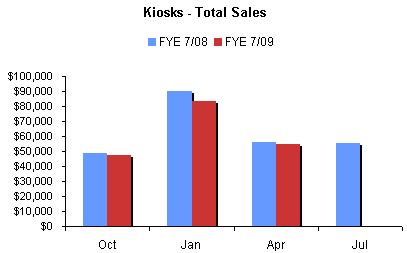
Source: Zale Corporation
- Sales per store in the fine jewelry segment have declined for the past two quarters, after edging ahead in the quarter ended October 2008, prior to the collapse of jewelry demand. This is no surprise.
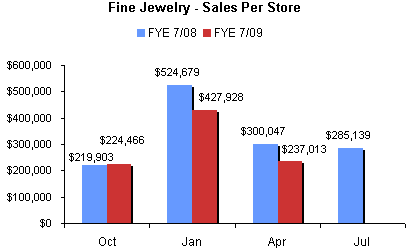
Source: Zale Corporation
- But Piercing Pagoda has continued to generate greater sales per unit, despite the recessionary economy.
Source: Zale Corporation
- Operating margins in the fine jewelry segment have continued to deteriorate on a quarterly basis, as would be expected, in the recessionary environment. The fine jewelry segment, which traditionally posts a healthy profit during the all-important holiday selling season (quarter labeled “Jan” below), was unprofitable this past year. So far, the fine jewelry segment has generated an operating loss for all three fiscal quarters year-to-date. Based on historical trends, it is unlikely that the fine jewelry segment will post a profit in the fourth fiscal quarter ending July 2009. Thus, the fine jewelry segment – the traditional jewelry stores that Zale owns – will not generate a profit this year.
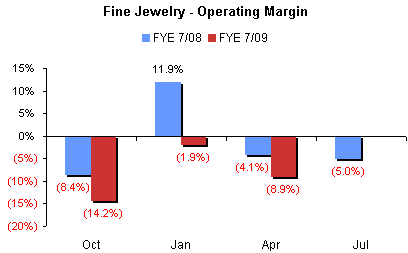 Source: Zale Corporation |
- The quarterly operating margins in the kiosk segment – Piercing Pagoda – have generally held up. In the most recent quarter, the segment posted a small operating profit. In the current weak economy, it is amazing to us that any jeweler can produce a profit. Based on historical trends, it is highly likely that Piercing Pagoda will generate an operating profit in the quarter ending July 2009. Thus, it would be the only Zale retail segment to generate a profit during the current fiscal year.
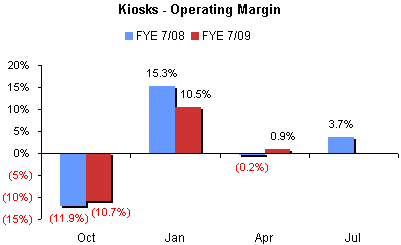
Source: Zale Corporation
What Is Piercing Pagoda’s Magic Formula?
In the current environment, consumers are shopping for value and lower-ticket items. In some quarters of the jewelry industry, this is called “flash for cash.” This is a perfect match with Piercing Pagoda’s offering.
In addition, Zale management has worked hard to upgrade the average ticket at Piercing Pagoda. Several years ago, the kiosk segment consistently yielded an average ticket around $36. For the most recent fiscal year, the kiosk segment’s average ticket rose to $40. Much of this is due to the addition of slightly higher priced merchandise – primarily opening price points for diamonds – to the sales mix.
Thus, in our view, the magic formula is a bit of being in the right place at the right time, coupled with some help from Zale’s management. The result: a profitable subsidiary. Could it be more profitable? We think that it could be more profitable as a free-standing entity with its own dedicated operations and support team than having to eat the crumbs left by its larger sibling, the fine jewelry segment.
Further, we don’t think that Wall Street is properly valuing Piercing Pagoda, and we worry that vendors have lumped it in with the rest of Zale’s operation.
